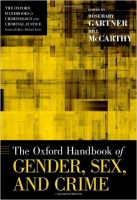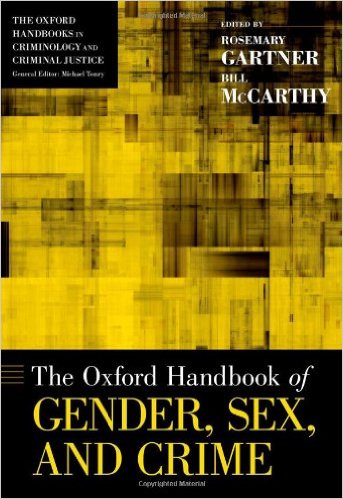 (Part of the Oxford Handbooks Series on Criminology and Criminal Justice)
(Part of the Oxford Handbooks Series on Criminology and Criminal Justice)
Editors: Rosemary Gartner and Bill McCarthy
Publisher: Oxford University Press – 723 pages
Book Review by: Paiso Jamakar
A book of this kind is rare and valuable because most others deal with research only on males when it comes to crime, gender, and sex. Very few books out there discuss research as it pertains to females.
Research on crime, gender and sex has been expanding in recent years to include:
- Studies from a variety of disciplines
- A growing number of countries
- A wider range of crimes
Fifty-five professors and researchers in the fields of criminology, history, law, psychology, sociology and others, related to the subject of this book, in the United States and Australia, Canada, and the United Kingdom, contributed to this book primarily by authoring its 35 chapters. They are grouped together within these six areas as shown below:
- Conceptual Issues / Current Controversies
- Historical Perspectives and Patterns
- Psycho- and Sociobiological Factors
- Social Science Perspectives and Research
- Reactions to Crime
- Gender, Sex, and Crime Globally
Among other topics, this book contains:
- Examinations of the contemporary and historical patterns of men’s and women’s involvement in crimes
- Perspectives – biological, psychological, and sociological – on criminal activity, gender, and sex
- Discussions of the ways gender and sex influence legal and popular reactions to crime
- Overviews of the intersections of sex and gender on the one hand, and age, class, community, ethnicity, and peer groups on the other
- Investigations of conventional topics such as domestic abuse and sexual violence, as well as new topics that have drawn the attention of researchers, such as gender violence during war, genocide, honor killing, human trafficking, and state rape
An interesting part of this book to look into is Chapter 4, Street Gangs: The Gendered Experiences of Female and Male Gang Members, written by Dana Peterson and Vanessa R. Panfil. Dana Peterson is an associate professor of criminal justice at the University of Albany, State University of New York. Vanessa Panfil is a post-doctoral associate at the Rutgers School of Criminal Justice.
Peterson and Panfil write that in books and articles in scholarly journals, gangs are characterized as the domain of males. Reports in the media as well, have also shown gang leaders and members to be typically males. In terms of the roles of females in gangs, they have been portrayed as one of the following:
- Love or sex interests
- Weapons
- Concealers or transporters of drugs so males could avoid detection by law enforcement
- Lures or spies to give gang males an advantage over rival gangs
The authors write: “…the gang context has been thought of as heteronormatively masculine. That is, gangs were regarded as hyper-masculine groups comprised overwhelmingly of heterosexual male members.”
But over the last two decades that has changed. The data shows that “females are often legitimate full-fledged gang members, underscoring the importance of sexual orientation, gender identity, and gender presentation for gang involvement.”
This article is an eye-opener that reveals surprising findings. In short, Panfil and Peterson state that their essay
- Discusses prevalence statistics and how these are shaped not only by sex but also by age, geographic location, race or ethnicity, and even the source of data
- Reveals the roles and activities of gang members, guided by the assertion that these experiences are structured by a gang’s sex composition (the ratio of males to females)
- Examines the reasons for, and th3e process of leaving the gang, long-term consequences of gang involvement, and the extent to which these are engendered
- Concludes with recommendations for future research, specifically calling on gang scholars worldwide to include females in their studies
This is an outstanding volume on crime, gender, and sex because it has been written by scholars whose studies are based on research, and whose articles include their own insight developed over long years of study and experience.
Editors:
Rosemary Gartner is Professor of Criminology and Sociology at the Center for Criminology and Sociological Studies at the University of Toronto
Bill McCarthy is Professor of Sociology at the University of California in Davis.







